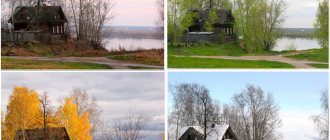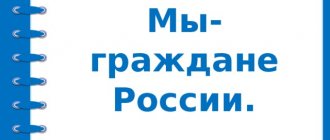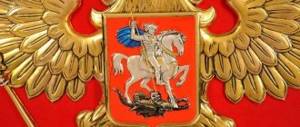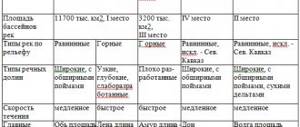Lesson summary on the topic “October Revolution”
Teacher's word: Now let's open the textbook at paragraph 12 - October Revolution. You have worksheets on your desks (Appendix No. 1). Today during the lesson we will fill them out. Now let's look at task 1 in the worksheet. Here you need to fill out the diagram"The teacher gives students to fill out a diagram based on paragraph 12 in the textbook on page 85 - paragraph: The last stage of the crisis and on pages 86 - 87, before the progress of the uprising.
The teacher listens and checks that the diagram is filled out correctly and, if necessary, corrects the students’ answer:
Suggested answer:
September 14, 1917 – The Democratic Conference met. It approved a coalition with the Cadets.
September 25, 1917 - the third coalition government was formed.
At the beginning of September 1917, by-elections to the Petrograd Soviet took place. The Bolsheviks have a majority in it.
September 5, 1917 - The Bolsheviks gained a majority in the Moscow Soviet.
October 10 - Lenin holds a secret meeting of the Central Committee. It adopted a resolution on an armed uprising.
October 12, 1917 - The Military Revolutionary Committee is created, headed by Trotsky.
Suggested answer:
— Objective and subjective. Objective - independent of people, Bolsheviks. These are: the deepening economic crisis, the mistakes of the Provisional Government. Subjective - dependent on the Bolsheviks. This is an increase in the number of the Bolshevik Party, slogans that are more understandable and closer to the people.
Teacher’s word: “Now, I will tell you how the revolution happened, and you listen to me and complete task No. 2 on the worksheet”
Teacher's story (Appendix No. 2)
The teacher listens and checks the correctness of the task; if something is wrong, he corrects the students’ answer.
Suggested answer:
Teacher's story (Appendix No. 2), students at this time complete task No. 3 in the worksheets (Appendix No. 1)
The teacher listens, checks the correctness of the task, and if something is wrong, then corrects the students’ answer.
Suggested answer:
On October 24, by order of the government, a detachment of police and cadets closed the printing house in which the Bolshevik newspaper Rabochy Put was printed. At a meeting of the Provisional Government, the question of arresting members of the Military Revolutionary Committee was raised. The Bolsheviks regarded these measures as the beginning of a “counter-revolutionary conspiracy.” The Military Revolutionary Committee sent out “Instruction No. 1” to all regiments of the Petrograd garrison and ships of the Baltic Fleet, about bringing soldiers and sailors to combat readiness. On the same day, armed detachments of the Red Guard and soldiers of Petrograd began to seize bridges, post offices, telegraphs, and train stations. By the morning of October 25, the capital, with the exception of the Winter Palace, was in the hands of the rebels. The Military Revolutionary Committee, in an address “to the citizens of Russia,” announced the seizure of power. At 21:40, following a signal from the cruiser Aurora, the capture of the Winter Palace began. On the night of October 26, the Winter Palace was taken. Kerensky managed to go to the front. The remaining members of the Provisional Government were arrested.
October 25, 1917 - The Second All-Russian Congress of Soviets of Workers' and Soldiers' Deputies meets. Adopts the first decrees: On peace, land and power.
The Decree on Peace proclaimed Russia’s exit from the war and Lenin appealed to the governments of other countries with a proposal for universal democratic peace, that is, peace without annexations and indemnities.
Suggested answer:
1. Annexation
- forcible annexation by a state of all or part of the territory of another state unilaterally.
2. Contribution
- payments imposed on the losing state in favor of the winning state.
Decree on Land - it was based on 242 peasant orders to the First Congress of Soviets. Provided for the transfer of land to peasants and the elimination of landownership.
Suggested answer:
- No. This is the agrarian program of the Socialist Revolutionaries. The Bolsheviks did not make such demands. They needed the peasantry to support them
Decree on Power - power is transferred to the Soviets, new Soviet authorities are created.
Suggested answer:
- because of the mistakes and inaction of the Provisional Government, because there was no force capable of standing up for it and the popularity of the Bolsheviks among the people and their slogans.
Teacher’s word: “So, let’s see what kind of authorities appear”
Teacher's story (Appendix No. 2).
As the teacher tells the story, students fill out the table in the worksheet (task No. 4)
The teacher listens, checks the correctness of the task, and if something is wrong, then corrects the students’ answer.
Suggested answer:
VTsIK – All-Russian Central Executive Committee. This is the legislative branch. Head Lenin.
SNK - Council of People's Commissars. Executive power. Head Sverdlov Yakov Mikhailovich.
VChK - All-Russian Extraordinary Commission for the fight against counter-revolution, i.e., forces opposing the Bolsheviks, profiteering and sabotage, i.e., failure to comply with the decrees of the Soviet government. This is the first punitive body. Headed by F. E. Dzerzhinsky.
Teacher’s word: “Now let’s complete the last 5th task in the worksheet (Appendix No. 1)”
The teacher invites students to open the textbook, paragraph 13, point 2 “Destruction of national and class inequality” and complete task No. 5 on the worksheet.
The teacher checks that the students completed the task correctly
Suggested answer:
A- 3, B- 1, C – 4, D – 2.
October Revolution
Explanation of new material
For many, the October Revolution of 1917 is the greatest event in the history of mankind, which allowed Russia to emerge from centuries of backwardness and ensure unprecedented growth rates in the economy and science. There are even more who believe that the Bolshevik coup pushed the country to the abyss.
Disputes on this issue will likely continue for a long time. In the book “The Russian Revolution from Lenin to Stalin,” the famous British historian and diplomat Edward Harleth Carr wrote: “Some will glorify the Russian revolution as a historical milestone in the liberation of mankind from oppression, others will curse it as a crime and a disaster.”
Each of you, of course, has the right to your own assessment of any historical event. If only it were sufficiently reasoned.
Why did the Bolsheviks manage to come to power?
Let's try to answer another question: why, of all the possible options for the development of Russia in 1917, did this one come true? Or, in other words, why did the Bolsheviks manage to seize power?
Both objective and subjective reasons contributed to their victory. We can classify as objective those that did not depend or almost did not depend on the actions of the Bolsheviks: the situation that had developed in the country by the fall of 17th, the actions of their opponents.
The bulk of the Russian population did not receive what it expected after the February Revolution.
All attempts by the Minister of Agriculture and Social Revolutionary leader Viktor Chernov to start agrarian reform did not receive any support in the Provisional Government. Also, the attempt by the Minister of Labor, Social Democrat Matvey Skobelev, to introduce civilized labor legislation ended in nothing. The political freedoms won in February were not enshrined in laws or the constitution. The elections to the Constituent Assembly were constantly postponed, and in the end they were scheduled only for November 12. The economic situation was getting worse every day. 4/5 of government spending went to military needs. Due to a lack of fuel and raw materials, more than 800 enterprises closed in the fall of 1917. About 3 and a half billion poods of grain were collected in the country, but the Provisional Government was able to receive only 280 million poods from the food allocation. The bread ration in Moscow and Petrograd was reduced to 200 per day, in the capital on some days it even decreased to 50. The increase in the issue of paper money led to their depreciation.
As a result, prices increased sharply (from January 1 to December 1, 1917 - more than 4 times). Compared to pre-war times, prices for bread increased 16 times, for potatoes - 20 times, and for granulated sugar - 27 times.
A dangerous situation was also developing at the front. In July-August 1917, Russian-Romanian troops thwarted a German attempt to break into Ukraine, but the German offensive in the Baltic states was much more successful. On August 21, the Germans took Riga, and by October 8, they took control of the entrances to the Gulf of Riga and the Gulf of Finland. This created a threat of an attack on Petrograd.
The Provisional Government not only did not solve all these problems, but did not even propose ways to solve them. The famous British writer and British intelligence agent William Somerset Maugham, who was in Petrograd from August to November 17, described the situation this way: “Kerensky made endless speeches. There was a moment when there was a danger that the Germans would move to Petrograd. Kerensky made speeches. Food shortages were becoming increasingly serious, winter was approaching, and there was no fuel. Kerensky made speeches. Lenin was hiding in Petrograd, they said that Kerensky knew where he was, but did not dare to arrest him. He made speeches."
The methods that General Kornilov proposed to lead the country out of the crisis could not suit the majority of the country's population - workers, peasants, soldiers (essentially the same peasants) who had already tasted freedom. The program he proposed included the dissolution of all elected bodies, “irresponsible organizations” - he meant, first of all, the Soviets and soldiers’ committees; continuation of the war “until the conclusion of a speedy peace”; “creating a combat-ready army and an organized rear” using the harshest methods, including the activities of military courts with the use of the death penalty. And postponing the resolution of “major state, national and social issues... until the Constituent Assembly.” Kornilov's ideas were supported by the officers and Cossacks. Financial assistance for his performance was provided by the largest Russian capitalists: Ryabushinsky, Morozovs, Tretyakov, Putilov...
But massive support was received by those who organized resistance to the attempt to establish a military dictatorship undertaken by Kornilov on August 27-31 - the Bolsheviks.
And here comes the turn to highlight the subjective reasons for the Bolshevik victory. That is, those that were associated with their own actions. The Bolsheviks, like General Kornilov, were not afraid to take power into their own hands and were ready to act with the harshest methods, including an armed uprising. They made the decision to prepare it at the end of July at the VI Congress of their party.
But, unlike Kornilov, the Bolsheviks offered the masses slogans that they were ready to support. “Peace to the peoples!”: on the second day after coming to power, the Bolsheviks promised to end the war. “Land for the peasants!”: Lenin understood that the Bolshevik program for creating public farms in the countryside would not arouse enthusiasm among rural workers, so he relied on the Socialist Revolutionary idea of socialization of the land - the elimination of private ownership of land and its free, equal distribution among peasants. “Factory for the workers!”: the introduction of workers’ control in enterprises, as well as control of the workers’ and peasants’ state in transport, in the financial system, in food distribution.
The famous Russian social democrat Menshevik Nikolai Sukhanov described the Bolshevik program for solving the food problem this way: “Trotsky (one of the Bolshevik leaders) resolved all food difficulties with one spirit that the sky became hot... The Soviet government will send a soldier, a sailor and a worker to every village (at dozens of rallies Trotsky for some reason spoke specifically about the worker); they will inspect the supplies of the wealthy, leave them as much as they need, and the rest for free - to the city or to the front... The St. Petersburg working masses enthusiastically greeted these promises and prospects... Rich and poor; The rich have a lot of everything, the poor have nothing; everything will belong to the poor, everything will be divided among the poor..."
The result of the growing popularity of the Bolsheviks was the Bolshevization of the Soviets, that is, an increase in the proportion of deputies who supported this party. Thus, by the beginning of November 17, the Bolsheviks occupied about 90% of the seats in the Petrograd Soviet, up to 60% in the Moscow Soviet, and the majority of seats in the Soviets of 80 large industrial cities. Since mid-September, the Moscow Soviet was headed by the Bolshevik Viktor Nogin, and the Petrosovet was headed by Leon Trotsky. The soldiers' committees of the Northern and Western fronts, the Petrograd garrison and the Central Committee of the Baltic Fleet went over to the side of the Bolsheviks.
October armed uprising
The leader of the Bolsheviks, Vladimir Lenin, believed that the current situation was most conducive to the victory of the armed uprising and it was no longer possible to delay its implementation. On October 10, he returned to Petrograd from Finland, where he was hiding from arrest. At a secret meeting of the Party's Central Committee, Lenin proposed immediately starting preparations for an uprising in Petrograd. Not all members of the Central Committee supported this proposal. Thus, prominent Bolsheviks Lev Kamenev and Grigory Zinoviev stated that the seizure of power was premature, and that the issue of power should be decided by the Constituent Assembly, then it would be legitimate (legal). But by a majority of votes (10 out of 12) the resolution on preparing an uprising was adopted. On October 12, the Military Revolutionary Committee (MRC) was created under the Petrograd Soviet, which was supposed to conduct the appropriate preparations. The main force of the uprising was to be the Red Guard units. By the beginning of November, they numbered about 20 thousand people in the capital. One could count on the support of 150 thousand soldiers of the Petrograd garrison and 80 thousand sailors of the Baltic Fleet. The headquarters of the uprising was the building of the Smolny Institute of Noble Maidens, where the Petrograd Soviet was located.
On October 24, the Provisional Government began open opposition to the Military Revolutionary Committee. On his orders, a detachment of cadets raided the Trud printing house, where the Bolshevik newspaper Rabochy Put was printed. The newspaper's circulation was confiscated and the building was blocked.
To protect the Winter Palace, where the government was located, it was planned to use a detachment of officers of 100 people, 2 thousand people from the school of warrant officers, a company of the women's shock battalion and cadets of the Mikhailovsky Artillery School. Kerensky gave the order to raise bridges in the city in order to separate the forces of the uprising participants. But most of the bridges by that time were already under the control of revolutionary soldiers and sailors. The Petrograd Telegraph Agency also came under the control of the rebels.
Late in the evening, Lenin arrived in Smolny from a safe house, believing that the actions were unfolding too slowly. His frantic energy greatly accelerated events. On the night of October 24-25, the rebels launched a decisive offensive. There was a systematic seizure of strategic points of the city and government institutions: the Main Post Office, Nikolaevsky Station, Central Power Plant, State Bank, Central Telephone Station, Warsaw Station, Mariinsky Palace. At 10 a.m., the Military Revolutionary Committee issued an appeal “To the Citizens of Russia,” which announced that the Provisional Government had been overthrown. At 2:35 p.m. an emergency meeting of the Petrograd Council of Workers' and Soldiers' Deputies opened. In his speech at it, Vladimir Lenin declared: “Comrades! The workers’ and peasants’ revolution, the need for which the Bolsheviks kept talking about, has taken place.” At 10:40 pm the 2nd All-Russian Congress of Soviets began its work in Smolny.
At this very time, the Winter Palace was being captured by revolutionary troops. The assault was scheduled for 6 pm, but since not all the detachments had time to arrive by this time, it was postponed. The delay in the assault also weakened the defenders of Winter. Some of them - cadets, Cossacks - left the palace. At 9:40 pm, a blank shot was fired at the Winter Palace by the bow gun of the cruiser Aurora, which became the signal for the assault. At 2:10 a.m. the Winter Palace was taken, the Provisional Government, except for Kerensky, who went to the front for reinforcements, was arrested. The number of victims of the armed struggle was insignificant - on both sides there were 6 killed and 50 wounded.
At 3:10 a.m. Lev Kamenev announced the fall of the Winter Palace and the arrest of the Provisional Government. The next day, Lenin read the Decrees on Peace and Land to the congress and proposed the formation of a Provisional Workers' and Peasants' Government - the Council of People's Commissars. Not all congress delegates approved of the Bolsheviks' actions. Representatives of moderate socialist parties - the Mensheviks and right-wing Socialist Revolutionaries - left the congress in protest. The Left Socialist Revolutionary Party, popular among peasants, voted for the transfer of power to the Soviets, but refused to join the Council of People's Commissars. So the first Soviet government consisted 100% of Bolsheviks. According to the decree of the Second Congress “On the formation of the Workers’ and Peasants’ Government”, the Council of People’s Commissars was elected before the convening of the Constituent Assembly. But subsequent events showed that having taken power into their own hands, the Bolsheviks were no longer going to give it up.
Following the capital, Soviet power was established in other regions of the country from the end of October 17th to February 18th. In 79 out of 97 large cities, the transfer of power into the hands of the Soviets occurred peacefully. This gave Lenin a reason to talk about the “triumphant march” of Soviet power. But in some regions, including Moscow, this transition cost a lot of blood. The cadets and officers led by Colonel Ryabtsev fought the Bolsheviks for a week. The city center changed hands several times. The fighting took place in the area of Nikitskaya Street and Arbat, Red Square and the Kremlin. Many historical buildings were damaged, including the Kremlin cathedrals.
According to various sources, from several hundred to several thousand people died. On November 10, the dead participants of the uprising who acted on the side of the Bolsheviks were buried in mass graves near the Kremlin wall. On November 13, a funeral service was held for the dead cadets and soldiers in the Church of the Great Ascension at the Nikitsky Gate. All of them can be considered the first victims of the fratricidal Civil War that soon broke out.







